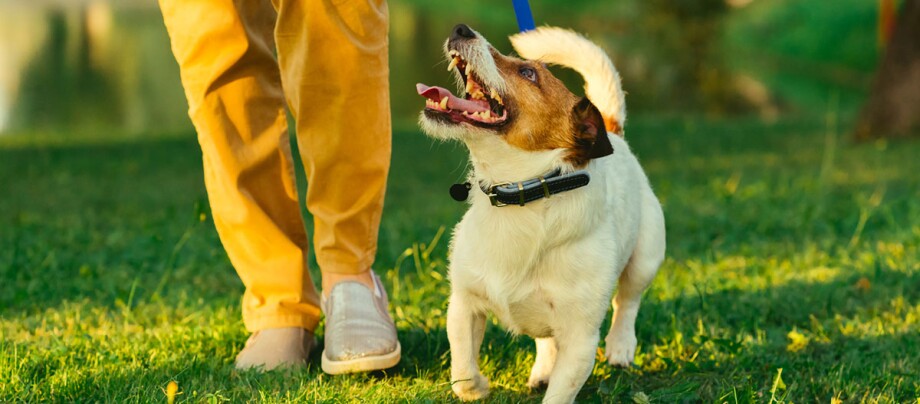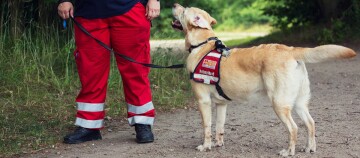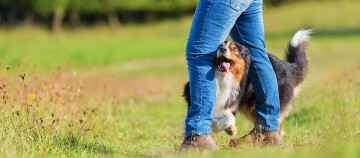Obedience Training for Your Dog and How to Become the Perfect Team
07.10.2022 - Reading time: 4 minutes

Obedience – this is the supreme discipline among dog sports. Here, everything revolves around the dog's obedience when executing commands. Teamwork between the dog and its human is top priority. This is because, in obedience, you and your dog complete the course together. Read on to find out how you and your dog can become a perfect team!
Obedience training past and present
Obedience training for dogs originated in England, where it was officially recognised as a dog sport in the 1950s. The term obedience refers to the training tasks that dogs have to perform as part of their guard dog training. You will also be familiar with some of the tasks from dog school and basic training of your dog. Obedience is also about the commands “Heel!”, “Down!”, “Sit!” or “Stay!”. But in obedience this is by no means everything and anything but easy.
In obedience training, the dog learns first and foremost to walk perfectly at heel so that he literally sticks to the dog handler’s leg and at the same time looks up at him attentively. But what makes modern obedience dog training different from that in our grandparents’ time?
Obedience is taught exclusively through positive reinforcement, reward and attention. Dominance and suppression of the dog through punishment and coercion have not been part of obedience training for a long time and should not be used in any dog school. Undesirable dog behaviour is ignored, while desired behaviour is reinforced through reward and encouragement. Obedience training is often combined with clicker training in which every correct reaction of the dog is recognised with a single click, followed by a reward.
Accuracy in the performance of tasks, attention and motivation of the dog as well as perfect interaction between the dog and the handler: these are the objectives of obedience training and form the criteria for judging in tournaments.
The exercises and tasks in obedience training do not require athletic or skilled dogs, as is the case in agility, for example. However, the range of tasks that the dog will progressively learn in training is wide and includes a variety of obedience exercises.
Obedience training exercises
- walking at heel
- stopping to sit/lie down
- changing positions between Sit, Stay and Down
- following commands at a distance and on the run
- independently going into a box, a marked field, at a distance
- retrieving with and without hurdles
- identifying an object belonging to the handler
- strength of character towards strangers and dogs
How does the dog sit after the command and how is its relationship with the handler? How attentively does the dog maintain eye contact and how fluently and smoothly does he follow the handler’s movements? The ability of both parties to work as a team is therefore an essential part of the goal of obedience training. Only a team that is well attuned to each other and that appears to work together as one fulfils the goals of obedience dog training.
Requirements for obedience
Whether young, old or handicapped – basically any dog can do obedience training and even participate in tournaments, because dogs are judged by group (young, old, handicapped) and sorted into classes (beginner or obedience level 1, 2 or 3). However, your dog must meet two requirements: He must be at least 15 months old and fully socialised. Aggressiveness towards other dogs or people is not tolerated and will result in exclusion from training or disqualification from the course.
Since obedience training requires a great deal of discipline from you and your dog as well as precise task setting, it is advisable, at least in the beginning, to attend expertly guided obedience training groups. This way you can avoid making mistakes in your training that are very difficult to correct later. To avoid frustration, it should be clear that there are breeds with very independent characters. The more independent the dog is, the more pointless absolute obedience will appear to it. Good examples in this respect are the Rhodesian Ridgeback and herding dogs in general.
An obedience exercise for getting to know each other: heeling for beginners
Get a taste of the basics of obedience training.
Try this small task:
- Step 1: Stand in front of your dog and hold a treat in your hand. Bring the closed hand with the treat to just below the dog’s chin with the command “Look here!” Your dog should look firmly at your hand.
- Step 2: Now take a few steps backwards and let your dog follow you as straightly as possible without losing his attention. If you are working with clickers, click when your dog takes the first step towards you.
- Step 3: Stop after a few steps and reward the dog.
- Step 4: Repeat the exercise up to step 3, but now turn 180 degrees in a clockwise direction and continue walking. The dog should follow you on your left side. Ideally, your dog should turn with its right shoulder close to your left leg and continue at this level. Click when the dog is at your leg level. Walk with him a few steps before rewarding it. Give your dog the treat from your left hand, holding it in front of his muzzle in such a way that he has to slow down a little, does not overtake you and continues to walk at your side. When turning, make sure that your dog is initially in front of you in a central position. If the dog is already pushing to your side before the turn, you must lure him back to the centre positions in front of you and then start to turn again.
If you would like more information about obedience and are interested in how national and international tournaments are run, please check out the relevant details on the website of the VDH (Verband für das deutsche Hundewesen [German Kennel Club Association]).


